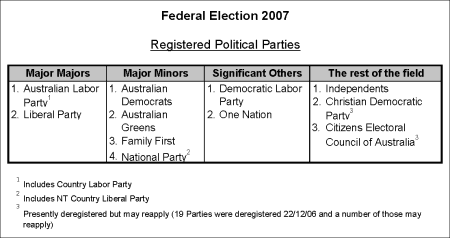Of these nine, the Nuclear Disarmament Party is not expected to contest the election, leaving eight main political brands in the race.

Political parties have many of the same characteristics as branded goods - high name recognition and high exposure increase the chance of purchase. Of course, reputation matters, so a continuous stream of deliberately negative coverage can reduce the purchase intention. As does reduced or no media coverage at all.
Advertisement
What are the chances of electoral success for these main political brands in 2007?
Based on past elections, it seems unlikely that anyone other than the Liberals, Labor, the Nationals and a few Independents can win House of Representative seats, although there is always an outside chance of a minor party upset. (The Democrats came close in Mayo in 1998, and the Greens won Cunningham in a by-election in 2002).
The Senate is a different matter. The Senate will be of much greater election interest than in the 2004 federal election because of widespread negative views generated by Coalition control of the Senate that resulted from that 2004 election.
There will be considerable voter interest in whether the Coalition Senate numbers can be reduced below half, and which of the minor parties will then hold the balance of power when the Liberal/National Coalition and the Labor Senators are in disagreement on an issue.
The Liberals and Labor are certain to win a swag of Senate seats and the Nationals and the Greens seem likely to win some seats, but the Democrats and Family First are considered outside chances, based on current senate polling.
The chances of election success are materially affected by popular support, incumbency, money, media coverage and polling booth coverage. For political parties sufficient media coverage is vital, and any deliberately negative coverage is damaging.
Advertisement
The table below shows that on all counts the Democrats will likely find the going tougher than the others. Yet the recent Senate polls in November 2006 have the Democrats at 5.5 per cent (Newspoll), and 5.4 per cent (Morgan). If Senator Fielding of Family First could get elected with just 1.9 per cent of the primary vote in Victoria in 2004, the Democrats can not be considered out of the race. (In the same Newspoll and Morgan Senate polls the Greens were 12.8 per cent and 10.5 per cent; and Family First was 2.5 per cent and 2.2 per cent.)

One intriguing question remains of where the parties and voters are in positioning terms. Brand managers will not only talk in terms of demographics but in terms of psychographics. Brand positioning covers both, and the critical matter is how buyers (voters) see themselves in relation to the brand.
Despite its obvious limitations, the “left-right” description still has very wide currency. In politics many people will describe themselves in policy terms as in the “centre” or “centre-left” or “centre-right” but will actually vote for a party that is none of those.
Positioning is a subjective matter. Below is my matrix for the main Australian political brands. Decide for yourself where you think the main political brands lie, and where you think your politics rests.

Discuss in our Forums
See what other readers are saying about this article!
Click here to read & post comments.
4 posts so far.